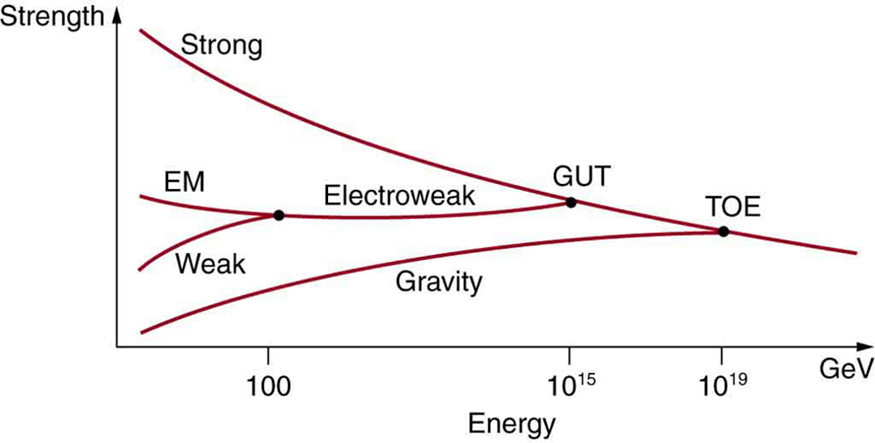| << Chapter < Page | Chapter >> Page > |

The small distances and high energies at which the electroweak force becomes identical with the strong nuclear force are not reachable with any conceivable human-built accelerator. At energies of about (16,000 J per particle), distances of about can be probed. Such energies are needed to test theory directly, but these are about higher than the proposed giant SSC would have had, and the distances are about smaller than any structure we have direct knowledge of. This would be the realm of various GUTs, of which there are many since there is no constraining evidence at these energies and distances. Past experience has shown that any time you probe so many orders of magnitude further (here, about ), you find the unexpected. Even more extreme are the energies and distances at which gravity is thought to unify with the other forces in a TOE. Most speculative and least constrained by experiment are TOEs, one of which is called Superstring theory . Superstrings are entities that are in scale and act like one-dimensional oscillating strings and are also proposed to underlie all particles, forces, and space itself.
At the energy of GUTs, the carrier particles of the weak force would become massless and identical to gluons. If that happens, then both lepton and baryon conservation would be violated. We do not see such violations, because we do not encounter such energies. However, there is a tiny probability that, at ordinary energies, the virtual particles that violate the conservation of baryon number may exist for extremely small amounts of time (corresponding to very small ranges). All GUTs thus predict that the proton should be unstable, but would decay with an extremely long lifetime of about . The predicted decay mode is
which violates both conservation of baryon number and electron family number. Although is an extremely long time (about times the age of the universe), there are a lot of protons, and detectors have been constructed to look for the proposed decay mode as seen in [link] . It is somewhat comforting that proton decay has not been detected, and its experimental lifetime is now greater than . This does not prove GUTs wrong, but it does place greater constraints on the theories, benefiting theorists in many ways.
From looking increasingly inward at smaller details for direct evidence of electroweak theory and GUTs, we turn around and look to the universe for evidence of the unification of forces. In the 1920s, the expansion of the universe was discovered. Thinking backward in time, the universe must once have been very small, dense, and extremely hot. At a tiny fraction of a second after the fabled Big Bang, forces would have been unified and may have left their fingerprint on the existing universe. This, one of the most exciting forefronts of physics, is the subject of Frontiers of Physics .

Notification Switch
Would you like to follow the 'College physics' conversation and receive update notifications?